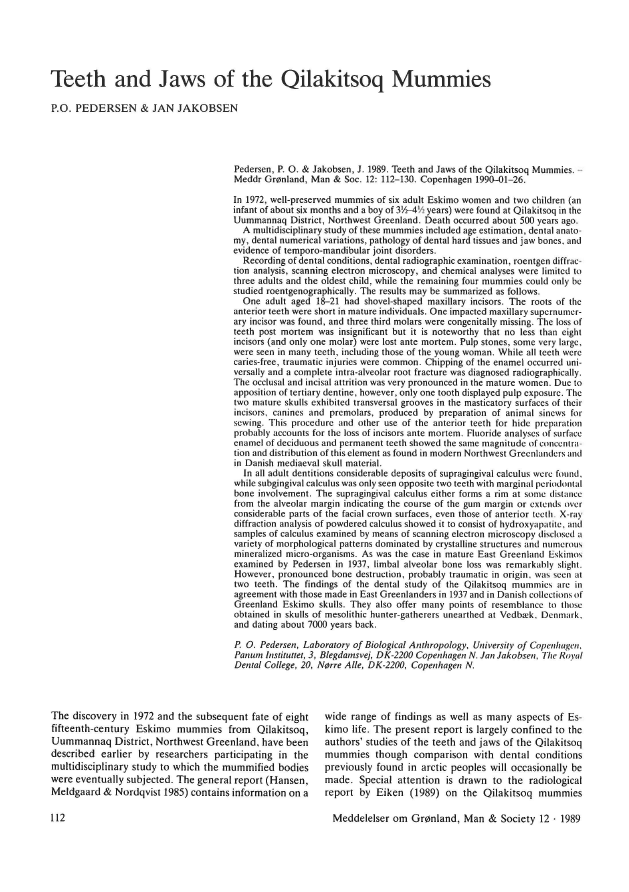Teeth and jaws of the Qilakitsoq mummies
DOI:
https://doi.org/10.7146/mog-ms.v12.146601Abstract
In 1972, well-preserved mummies of six adult Eskimo women and two children (an infant of about six months and a boy of 3½ – 4½ years) were found at Qilakitsoq in the Uummannaq District, Northwest Greenland. Death occurred about 500 years ago.
A multidisciplinary study of these mummies included age estimation, dental anatomy, dental numerical variations, pathology of dental hard tissues and jaw bones. And evidence of temporo-mandibular joint disorders. Recording of dental conditions, dental radiographic examination, roentgen diffraction analysis, scanning electron microscopy, and chemical analyses were limited to three adults and the oldest child, while the remaining four mummies could only be studied roentgenographically. The results may be summarized as follows.
One adult aged 18–21 had shovel-shaped maxillary incisors. The roots of the anterior teeth were short in mature individuals. One impacted maxillary supernumerary incisor was found, and three third molars were congenitally missing. The loss of teeth post mortem was insignificant but it is noteworthy that no less than eight incisors (and only one molar) were lost ante mortem. Pulp stones, some very large, were seen in many teeth, including those of the young woman. While all teeth were caries-free, traumatic injuries were common. Chipping of the enamel occurred universally and a complete intra-alveolar root fracture was diagnosed radiographically.
The occlusal and incisal attrition was very pronounced in the mature women. Due to apposition of tertiary dentine, however, only one tooth displayed pulp exposure. The two mature skulls exhibited transversal grooves in the masticatory surfaces of their incisors. canines and premolars, produced by preparation of animal sinews for sewing. This procedure and other use of the anterior teeth for hide preparation probably accounts for the loss of incisors ante mortem. Fluoride analyses of surface enamel of deciduous and permanent teeth showed the same magnitude of concentration and distribution of this element as found in modern Northwest Greenlanders and in Danish mediaeval skull material.
In all adult dentitions considerable deposits of supragingival calculus were found. while subgingival calculus was only seen opposite two teeth with marginal periodontal bone involvement. The supragingival calculus either forms a rim at some distance from the alveolar margin indicating the course of the gum margin or extends over considerable parts of the facial crown surfaces, even those of anterior teeth. X-ray diffraction analysis of powdered calculus showed it to consist of hydroxyapatite, and samples of calculus examined by means of scanning electron microscopy disclosed a variety of morphological patterns dominated by crystalline structures and numerous mineralized micro-organisms. As was the case in mature East Greenland Eskimos examined by Pedersen in 1937, limbal alveolar bone loss was remarkably slight.
However, pronounced bone destruction, probably traumatic in origin. was seen at two teeth. The findings of the dental study of the Qilakitsoq mummies arc in agreement with those made in East Greenlanders in 1937 and in Danish collections of Greenland Eskimo skulls. They also offer many points of resemblance to tl10~e obtained in skulls of mesolithic hunter-gatherers unearthed at Vedbæk. Denmark. and dating about 7000 years back.

Downloads
Published
Issue
Section
License
Coypyright by the authors and the Commision for Scientific Research in Greenland / Danish Polar Center/Museum Tusculanum Press as indicated in the individual volumes. No parts of the publications may be reproduced in any form without the written permission by the copyright owners.
